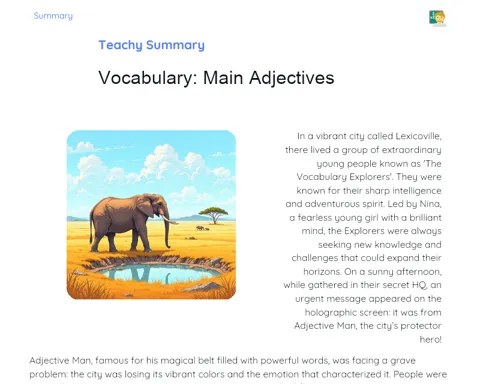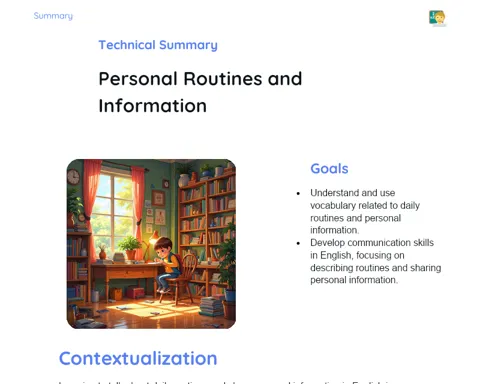Relative Pronouns: Introduction | Traditional Summary
Contextualization
Relative pronouns are words we use to connect sentences or clauses, making our communication more fluid and efficient. They allow us to add information about people, places, things, or possessions without the need to repeat words. For example, instead of saying 'The book is interesting. The book is on the table.', we can use a relative pronoun to say 'The book that is on the table is interesting.' This way, we avoid repetition and enrich our sentence with more details.
In the English language, the main relative pronouns are 'who', 'which', 'that', and 'whose'. Each of them has a specific use depending on the context and the type of information we want to add. 'Who' is used to refer to people, 'which' is used for things or animals, 'that' can be used for both people and things, and 'whose' is used to indicate possession. Understanding and correctly using these pronouns is essential for constructing cohesive and clear sentences.
Who
The relative pronoun 'who' is used to refer to people. It serves as the subject or object within the subordinate clause, adding relevant information about a person mentioned in the main sentence. This pronoun is essential to avoid repeating names or personal pronouns, making communication more elegant and efficient. For example, instead of saying 'The teacher is very intelligent. The teacher teaches Mathematics.', we can simplify and say 'The teacher who teaches Mathematics is very intelligent.' In this way, 'who' connects the two ideas cohesively.
In practice, 'who' is used in sentences like 'The girl who is talking to John is my sister.' Here, 'who' refers to the 'girl' and introduces the additional information that she is talking to John. It's important to note that 'who' is always used when the antecedent is a person or a group of people. It can be replaced by 'whom' when it serves as the object, although 'whom' is less common in contemporary English.
Understanding the use of 'who' is crucial for building complex and cohesive sentences in English. By mastering this relative pronoun, students will be able to provide more detailed descriptions and avoid unnecessary repetition of words, improving the clarity and fluency of their written and spoken communication.
-
'Who' is used to refer to people.
-
Connects ideas by avoiding the repetition of names or personal pronouns.
-
Is used both as a subject and as an object in the subordinate clause.
Which
The relative pronoun 'which' is used to refer to things or animals in a sentence. It introduces additional information about an object or animal referred to earlier, providing a more detailed description without the need to repeat the noun. For example, instead of saying 'The book is interesting. I read the book.', we can use 'which' to say 'The book that I read is interesting.' This makes communication more fluid and less redundant.
In practical contexts, 'which' can be seen in sentences like 'The car, which is red, belongs to my brother.' Here, 'which' refers to 'car' and adds the information that the car is red. It's important to note that 'which' is used exclusively for objects and animals, never for people. Furthermore, 'which' is often used in non-restrictive clauses, which provide additional information without altering the main meaning of the sentence.
Mastering the use of 'which' is essential for constructing descriptive sentences in English. By using this relative pronoun correctly, students can create richer and more detailed descriptions, improving the clarity and accuracy of their written and verbal communications.
-
'Which' is used to refer to things or animals.
-
Introduces additional information without repeating the noun.
-
Is often used in non-restrictive clauses.
That
The relative pronoun 'that' is versatile, referring to both people and things. It is often used in informal contexts or when the information it introduces is essential to the meaning of the sentence. For example, instead of saying 'The car is new. The car was bought by John.', we can simplify and say 'The car that John bought is new.' Here, 'that' connects the two ideas cohesively and directly.
'That' is used to connect sentences or clauses and add essential information without the need to repeat words. It is employed for both people and things, providing flexibility in sentence construction. For example, instead of saying 'The car is new. The car is red.', we can use 'that' to say 'The car that is red is new.', eliminating repetition and making the sentence clearer and more efficient. In formal contexts, 'that' is often replaced by 'who' or 'which', but remains a common choice in everyday conversation and informal texts.
Understanding the use of 'that' is fundamental for constructing complex and efficient sentences in English. This relative pronoun allows for the addition of essential information cohesively, improving the fluency and clarity of written and spoken communication. By mastering 'that', students will be able to create more detailed descriptions and avoid unnecessary repetition of words, enhancing their language skills in various contexts.
-
'That' can refer to both people and things.
-
Is often used in informal contexts.
-
Introduces essential information for the meaning of the sentence.
Whose
The relative pronoun 'whose' is used to indicate possession, referring to people, animals, or things. It introduces a clause that describes something belonging to someone or something, providing an efficient way to add information about ownership without repeating possessive pronouns. For example, instead of saying 'The student lost the book. The student's book is new.', we can simplify and say 'The student whose book is new lost it.' In this way, 'whose' connects the two ideas cohesively.
In practice, 'whose' is used in sentences like 'The artist whose paintings are displayed here is very talented.' Here, 'whose' refers to the artist and indicates that the paintings belong to him. This pronoun is essential for creating detailed descriptions and avoiding unnecessary repetition of words. Additionally, 'whose' can be used for both people and animals and things, making it a versatile and important relative pronoun in constructing complex sentences.
Understanding the use of 'whose' is crucial for constructing cohesive and detailed sentences in English. By mastering this relative pronoun, students will be able to provide more precise descriptions and avoid the repetition of possessive pronouns, improving the clarity and fluency of their written and spoken communication.
-
'Whose' indicates possession and refers to people, animals, or things.
-
Introduces a clause that describes something belonging to someone or something.
-
Helps to avoid the repetition of possessive pronouns.
To Remember
-
Relative Pronouns: Words that connect sentences or clauses to add additional information.
-
Who: Relative pronoun used to refer to people.
-
Which: Relative pronoun used to refer to things or animals.
-
That: Relative pronoun used for both people and things, usually in informal contexts.
-
Whose: Relative pronoun used to indicate possession, referring to people, animals, or things.
Conclusion
In this lesson, we learned about the relative pronouns 'who', 'which', 'that', and 'whose' and their specific functions in the structure of sentences in English. 'Who' is used to refer to people, 'which' for things or animals, 'that' can be used for both, and 'whose' indicates possession. Understanding and correctly using these pronouns is essential for constructing cohesive and clear sentences.
Relative pronouns help to connect sentences or clauses and introduce additional information without the need to repeat words, which makes communication more fluid and efficient. They are fundamental in both written and spoken language, allowing for more detailed descriptions and avoiding unnecessary repetition.
Mastering the use of relative pronouns is crucial for improving clarity and precision in communication in English. By understanding how and when to use each pronoun, students can create more complex and cohesive sentences, which is especially important in academic and formal contexts.
Study Tips
-
Review the examples given in class and try to create your own sentences using each relative pronoun to reinforce learning.
-
Practice reading texts in English, identifying the relative pronouns and understanding how they connect ideas and add information.
-
Do exercises combining sentences and completing sentences with the appropriate relative pronouns to consolidate knowledge.



